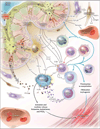Asthma phenotypes and interleukin-13--moving closer to personalized medicine
- PMID: 21879891
- PMCID: PMC4390041
- DOI: 10.1056/NEJMe1108666
Asthma phenotypes and interleukin-13--moving closer to personalized medicine
Figures

Comment on
-
Lebrikizumab treatment in adults with asthma.N Engl J Med. 2011 Sep 22;365(12):1088-98. doi: 10.1056/NEJMoa1106469. Epub 2011 Aug 3. N Engl J Med. 2011. PMID: 21812663 Clinical Trial.
References
-
- Busse WW, Lemanske RF., Jr Asthma. N Engl J Med. 2001;344:350–362. - PubMed
-
- Szefler SJ, Martin RJ, King TS, et al. Significant variability in response to inhaled corticosteroids for persistent asthma. J Allergy Clin Immunol. 2002;109:410–418. - PubMed
-
- Bateman ED, Boushey HA, Bousquet J, et al. Can guideline-defined asthma control be achieved? The Gaining Optimal Asthma Control study. Am J Respir Crit Care Med. 2004;170:836–844. - PubMed
-
- Humbert M, Beasley R, Ayres J, et al. Benefits of omalizumab as add-on therapy in patients with severe persistent asthma who are inadequately controlled despite best available therapy (GINA 2002 step 4 treatment): INNOVATE. Allergy. 2005;60:309–316. - PubMed
